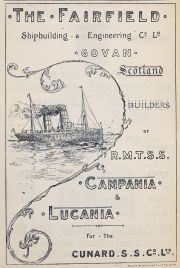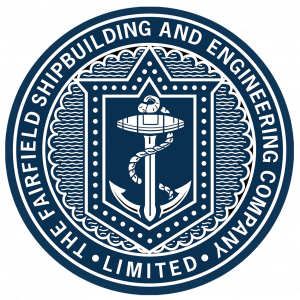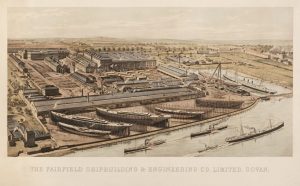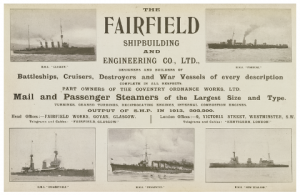The Fairfield Shipbuilding and Engineering Company, located in Govan, Glasgow, Scotland, was one of the most prominent shipbuilding firms of the 19th and 20th centuries. Renowned for constructing some of the world’s finest ships, Fairfield’s history reflects the evolution of shipbuilding technologies, the changing political landscape, and the impact of global economic shifts.
Founding and Early Years (1834–1860s)
Fairfield’s roots trace back to 1834 when Charles Randolph founded a small engineering works in Tradeston, Glasgow, specializing in general engineering and steam engine production. In 1852, John Elder, a gifted engineer with a particular interest in marine engineering, joined Randolph as a partner. Elder introduced several revolutionary innovations, including the compound steam engine, which significantly improved the efficiency of marine propulsion.

Key milestones during this era:
1858: John Elder and Charles Randolph moved the operations to the banks of the River Clyde, acquiring land in Govan, a location that allowed for direct access to shipbuilding docks.
1860: The firm expanded into shipbuilding and was renamed Randolph, Elder & Co. This move into shipbuilding coincided with the increasing demand for iron-hulled steamships, and the company quickly established a reputation for engineering excellence.
Elder’s compound engine invention, which reduced coal consumption, made the company highly competitive. By the 1860s, Randolph, Elder & Co. was known for building high-efficiency steamships, helping establish Glasgow as a major shipbuilding centre on the world stage.
Establishment as Fairfield Shipbuilding and Engineering (1868–1890s)
John Elder passed away in 1869, leaving his widow, Isabella Elder, in charge. Isabella played a pivotal role in preserving her husband’s legacy and fostering the company’s growth. Under her stewardship, the company was restructured and renamed the Fairfield Shipbuilding and Engineering Company in 1868, after the Fairfield Estate on which it was located.

Key achievements:
1870s: Fairfield began focusing on building larger vessels, primarily for commercial and military use. The company’s attention to precision and innovation attracted major contracts from international shipping lines and naval forces.
1880s: Fairfield gained recognition for constructing fast ocean liners for companies like the Cunard Line and the Peninsular and Oriental Steam Navigation Company (P&O). The shipyard also became known for building warships for the British Royal Navy.
Fairfield’s adoption of new technologies and its pioneering work in steam propulsion gave it a competitive edge. The company’s growing workforce reflected its importance, with Govan becoming one of the centres of shipbuilding in the world.
Golden Age and Expansion (1900–World War I)
At the turn of the 20th century, the Fairfield Shipyard entered its golden age. By this time, Govan was one of the most important shipbuilding hubs globally, and Fairfield stood at the heart of that development.
Technological advancements and significant projects:
1900–1914: Fairfield contributed to the construction of some of the fastest and most luxurious ocean liners of the era, including vessels for Cunard and Anchor Line. The yard built ships such as the RMS Campania and RMS Lucania, known for their speed and opulence.
Warship construction: During this period, Fairfield became a leading manufacturer of naval vessels, securing contracts with the Royal Navy. The company constructed battlecruisers and destroyers, including the famous HMS Inflexible.
World War I impact:
During World War I, Fairfield played a crucial role in producing military vessels, such as destroyers, cruisers, and submarines, for the British war effort. The shipyard employed thousands of workers and operated at full capacity to meet wartime demands.
By 1918, Fairfield had firmly established itself as one of the most prominent shipyards in the world, benefiting from both military and commercial success.

Post-War Decline and Challenges (1920s–1939)
After World War I, the global shipbuilding industry experienced a significant downturn, and Fairfield was not immune to the broader economic issues affecting the sector. A glut of ships from the war, coupled with declining international trade, meant that shipbuilding orders slowed dramatically.
Key challenges:
1920s–1930s: Fairfield experienced financial difficulties, exacerbated by the Great Depression of the 1930s. Despite these challenges, the company managed to survive through a combination of naval orders and restructuring.
1924: Fairfield was acquired by Lithgows Ltd, another Clyde-based shipbuilder. Although this merger offered temporary financial relief, the shipyard struggled with fluctuating demand and the increasingly competitive international shipbuilding market.
Despite these difficulties, Fairfield continued to build notable ships, such as HMS Hood, one of the most famous battlecruisers ever constructed. However, the company’s profitability was inconsistent during this era, with the Great Depression severely limiting commercial orders.
World War II and Post-War Boom (1939–1960s)
The outbreak of World War II brought a surge in demand for military ships once again. Fairfield, like many Clyde shipyards, played a pivotal role in supporting the British war effort, constructing warships, aircraft carriers, and other naval vessels.
World War II and immediate post-war years:
1939–1945: Fairfield contributed significantly to the construction of destroyers, aircraft carriers, and other warships, employing thousands of workers.
Post-1945: The shipyard enjoyed a brief post-war boom as the world’s merchant and naval fleets needed rebuilding. Fairfield secured many orders, especially from the British Navy and commercial shipping lines, including tankers, freighters, and passenger vessels.
However, the global shipbuilding industry began to change rapidly in the 1950s and 1960s. Fairfield, along with other British shipyards, faced increasing competition from countries like Japan, where shipbuilding was cheaper due to lower labour costs and more advanced production methods.

Decline, Nationalization, and Closure (1970s–1990s)
The 1970s marked a period of serious decline for Fairfield and British shipbuilding as a whole. As international competition grew, Fairfield’s profitability declined, leading to severe financial challenges.
Nationalization and last efforts:
1969: Fairfield was nationalized as part of the Upper Clyde Shipbuilders (UCS) consortium in an attempt to save Glasgow’s shipbuilding industry. The consortium, however, faced severe financial difficulties and went into liquidation in 1971, prompting protests and sit-ins by workers.
1970s: The shipyard was restructured and privatized once again, but it struggled to secure enough orders to remain competitive. The government offered financial support, but it was clear that Fairfield, along with the entire British shipbuilding sector, was in decline.
Final years:
By the 1980s, the shipyard had drastically reduced operations. In 1984, Fairfield finally ceased shipbuilding operations, marking the end of an era for Govan.
Legacy and Modern Transformation (2000s–Present)
Though Fairfield Shipbuilding and Engineering ceased to exist as a major shipbuilding entity, its legacy lives on. The site in Govan is still associated with maritime and defence industries.
Key developments:
BAE Systems: In the 1990s, parts of the old Fairfield yard were incorporated into BAE Systems Surface Ships, which continues to produce naval vessels for the British government, keeping shipbuilding alive in Govan.
Preservation: The Fairfield heritage has also been preserved through the Fairfield Heritage Centre, which opened in 2013, dedicated to showcasing the shipyard’s history and contributions to world shipbuilding.
The Fairfield Shipyard, with its reputation for excellence, technical innovation, and the construction of some of the most iconic ships of the 19th and 20th centuries, remains a symbol of Scotland’s maritime heritage.

